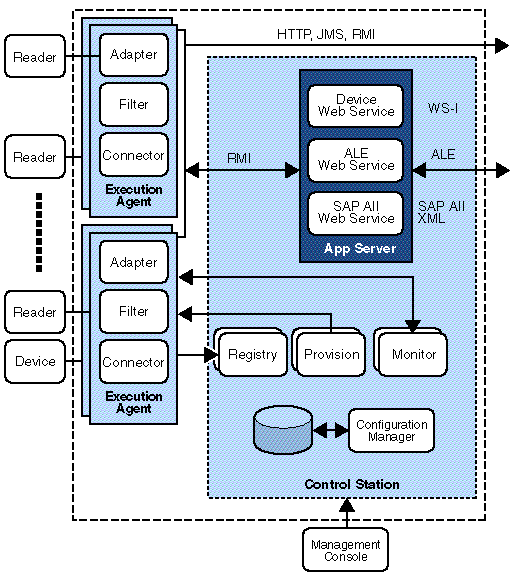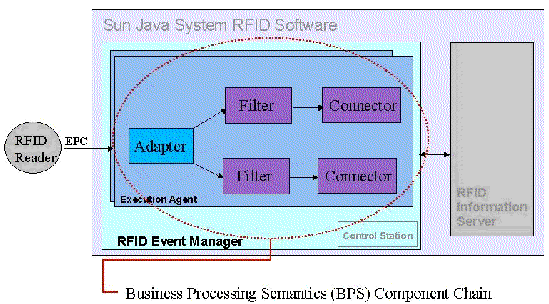| C H A P T E R 1 |
|
Introduction to Sun Java System RFID Software Programming Platform |
This chapter describes the architecture of the Sun Java System RFID Software 3.0 (RFID Software) and introduces the programming mechanisms that are available for using the information generated by the physical devices that comprise your RFID network. Subsequent chapters contain more details. The following topics are covered in this chapter:
System RFID Software 3.0 (RFID Software) and introduces the programming mechanisms that are available for using the information generated by the physical devices that comprise your RFID network. Subsequent chapters contain more details. The following topics are covered in this chapter:
The RFID Software consists of the following four major modules:
The RFID Event Manager communicates with RFID sensor devices to gather information from the physical world. This information can be stored in the RFID Information Server for future analysis. The information can also be sent continuously to third-party applications as it arrives at the RFID Event Manager.
The RFID Configuration Manager is a graphical user interface (GUI) application that is used to specify the set of devices connected to the RFID Event Manager. You also use the RFID Configuration Manager to statically define how to process the information within the RFID Event Manager and where to send the information after this processing.
You can also use the RFID Event Manager to dynamically specify how to process the incoming information and define the subsequent consumers of the processed information. This guide describes the programming mechanisms that developers can use to dynamically control sensor devices and to define rules for processing the information collected by the devices.
You use the RFID Management Console to monitor and manage the status of the devices that are connected to the RFID Event Manager. The RFID Management Console enables system administrators to monitor statistics and change runtime parameters for each of these devices.
The RFID Event Manager is a distributed platform consisting of a single Control Station and one or more Execution Agents. In the simplest and most common scenario, the Execution Agent and Control Station are installed on the same computer. The Execution Agent is responsible for communicating with the physical devices, processing the information, and posting the information to the consumers of the information. The system administrator uses the RFID Configuration Manager, which is installed as part of the Control Station component, to create one or more Configuration Objects. A Configuration Object specifies one or more devices to control and specifies a set of components that process the device information. The set of information-processing components is called a Business Processing Semantic Unit (BPS).
In the simplest scenario, each Configuration Object is executed by a single Execution Agent. In a large RFID network with many deployed devices, the RFID Event Manager functionality is scaled by installing multiple Execution Agents on separate computers. In this more complex deployment, the Control Station provisions each of the Configuration Objects to a separate Execution Agent in round-robin fashion. The Control Station continuously monitors the status of the Execution Agents. To provide high processing availability, if an Execution Agent fails, the Configuration Object is provisioned to another Execution Agent.
The following illustration shows the overall components and communication flows comprising the RFID Software.

A Configuration Object consists of a collection of components called adapters, filters, and connectors. The components are linked in a chain to process events arriving from the RFID devices. Typically, an adapter component begins the chain by receiving information from the device and sending information to the device. Filters are used in the middle of the chain to remove noise, such as excessive read events, or to perform other data manipulation. Connectors (also called loggers) are at the end of the chain to collect data for back-end processes or listeners (also called consumers). A back-end process might be the RFID Information Server or a third-party software application. The following figure shows an example of a Configuration Object receiving information from an RFID reader and posting the processed information to the RFID Information Server.

The components of the Configuration Object are defined as follows:
As the name implies, the RFID Event Manager is an event-driven platform. Components (adapters, filters, and connectors) generate events to communicate with each other. Every component is an event producer, and every component can register itself with other components to consume their events. Typically, an adapter listens and/or queries the physical device for information. The information is then packaged inside an event object, and this event object is posted to the listeners that were previously registered with the adapter. As shown in FIGURE 1-1, the adapter receives Electronic Product Code (EPC) information from the RFID device, packages the information as an Identifier object and posts the event to the two filters that have previously registered themselves as consumers of the adapter events. The filters, in turn, manipulate the information and post the events to the respective connector, which consumes the events from a particular reader. The connector then packages the event in a manner that is understood by the application that consumes the event.
|
Note - The Javadoc documentation for the RFID Software is available as part of the Sun Java System RFID Software Toolkit. See To Download and Install the RFID Software Toolkit for information on getting the toolkit. |
RFID data captured by adapters is packaged in Identifier objects. See the API specifications (Javadoc documentation) for the com.sun.autoid.identity package - rfid-toolkit-dir/docs/api/index.html.
Identifier Objects include the following:
In addition to the unique ID, the Identifier object might contain a set of generic properties. The properties can be interpreted by the filters in an application-dependent manner. See the Javadoc documentation for the RfidTag object.
The RFID Event Manager components, adapters, filters, and connectors, can generate and consume event objects from other components. See the API specifications for the com.sun.autoid.event package - rfid-toolkit-dir/docs/api/index.html. The base class is Event.
Event objects include the following:
a. IdentifierEvent - This object carries a single Identifier object, which represents the EPC (Electronic Product Code) or other type of identifier detected by the device, and any other properties that are specific to the adapter and application.
b. IdentifierListEvent - This object is similar to IdentifierEvent, but carries multiple Identifier objects that were detected by the same device.
c. DeltaEvent - This object carries multiple Identifier objects, but separates the information into two categories:
i. Objects coming into the device's field of view
ii. Objects moving out of the device's field of view
This guide provides details on how to create custom filters and connectors. You can create custom event types, provided they are sub-classed from com.sun.autoid.event.Event. If you create your own event types, then your filter cannot feed other filters and connectors that do not know how to handle the new event type. The best practice is to support the IdentifierEvent, IdentifierListEvent, DeltaEvent, StatusEvent, and MiscEvent types in your filters and connectors and refrain from creating new event types unless absolutely necessary.
There are four main mechanisms for consuming information generated by the devices connected to the RFID Event Manager.
The EPCglobal Application Level Events (ALE) Specification, Version 1.0 specifies only one-way communication to the device to obtain RFID tag identifier information. The specification does not implement a mechanism for getting tag user data, for programming tags, or for managing the devices. Any Java or non-Java application that complies with the EPCglobal ALE 1.0 specification can communicate with the RFID Event Manager.
At the time of this release, EPCglobal is in the process of defining a new version of the ALE specification that will specify a standard method to obtain user data and program tags, among other things. Sun Microsystems, Inc. is actively participating in the definition of this standard and plans to provide an updated library and implementation as the specification process progresses.
These mechanisms are not mutually exclusive. You can use them in conjunction with each other to achieve a task. You might choose to use ALE to obtain tag information, and then use the device access web services to get user data and program tags. There may be applications where you want to mix and match web service and Java APIs. For example, you might use the Java ReaderClient API to communicate with RFID devices in your local network and use the ALE Java library or the device access web services to communicate with an RFID Event Manager in a remote network across the continent.
Many times an application needs to get device identification or to control the gathering and sending of information. Use the Java ReaderClient APIs or web services for device access APIs to instruct a device when to start gathering data, to stop gathering data, to get device status and to get device identification information.
System administrators can use the RFID Management Console to perform these same tasks from a web interface without any need for programming. See the Sun Java System RFID Software 3.0 Administration Guide for details on using the RFID Management Console.
Copyright © 2006, Sun Microsystems, Inc. All Rights Reserved.